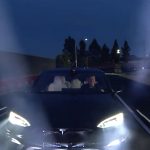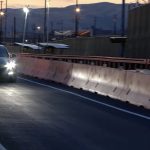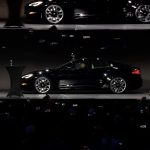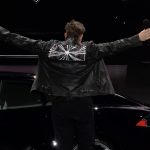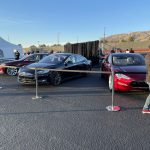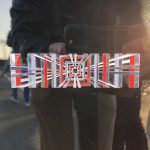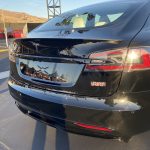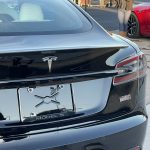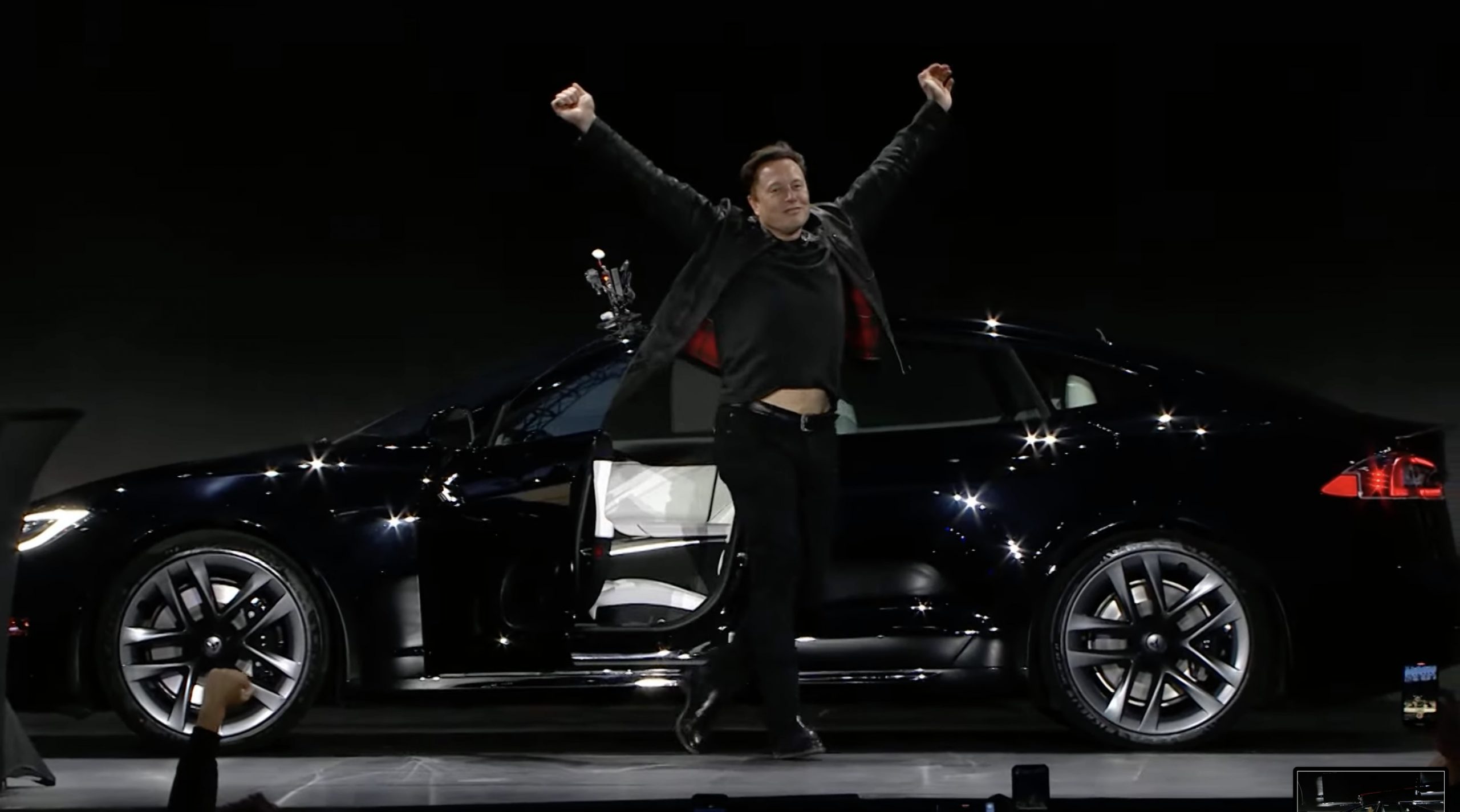
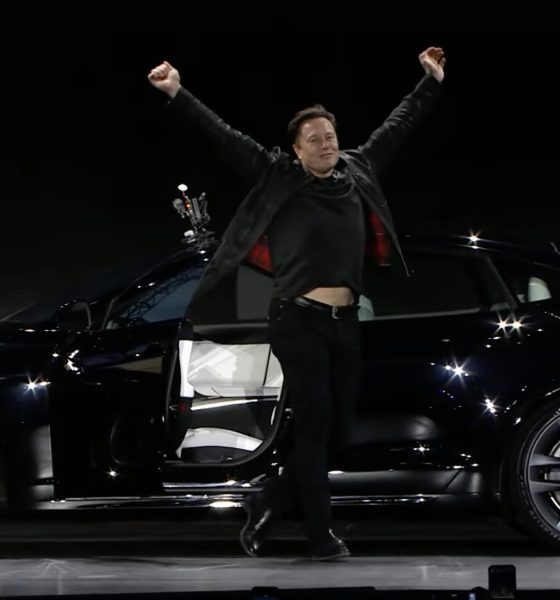
News
Tesla Model S Plaid with ‘practically alien’ tech unleashed: 1000 hp, lowest drag coefficient, and PS5-level gaming
The Tesla Model S Plaid formally made its debut at the company’s delivery event at the Fremont Factory today. The expectations for the Model S Plaid were high in the days leading up to its first deliveries, particularly as Tesla retired the Model S Plaid+ and raised the Model S Plaid’s base price by $10,000.
“Tonight we’re going to show you the next BEST version of the Model S,” Tesla Chief designer Franz von Holzhausen said at the beginning of the event.
Elon Musk launched the Tesla Model S through the company’s newly finished test track and triumphantly celebrated the Plaid’s arrival on stage. In honor of the event and the new Model S Elon Musk wore a jacket with the plaid design at the back.
- (Credit: Tesla)
- (Credit: Tesla)
- (Credit: Tesla)
- Tesla CEO Elon Musk wears a Plaid Mode jacket at the company’s Model S Plaid Delivery Event on June 10th, 2021. (Credit: Tesla)
Below are the official specifications and details of the Model S Plaid.
Price and Range
When Tesla announced the Model S Plaid during the release of its Q4 and FY 2020 Update Letter, the company listed the vehicle with an estimated EPA range of 390 miles per charge. The Plaid+ variant, which was discontinued, had a range similar to the Cybertruck with more than 500 miles per charge. Elon Musk described the Plaid’s speed as
Tesla also improved the Model S car’s Supercharging speed to 187 miles of range in 15 minutes. This is notable, as the Supercharger Network has now grown to 25,000 stations worldwide.
MODEL S PLAID TEST
At Fremont today pic.twitter.com/FQXXMAXWhU— JPR007 (@jpr007) June 11, 2021
During the lead up to the flagship Tesla sedan’s deliveries, images of a Model S Plaid test unit’s Monroney sticker made the rounds online. The sticker listed some interesting information, including a range of 405 miles per charge. This is quite a bit higher than the 390 miles originally announced earlier this year, but lower than the 500+ miles of range that was listed for the discontinued Model S Plaid+.
During the event, Tesla officially announced that the Model S Plaid would have a range of 390 miles per charge.
Battery and Electric Motor
The Model S Plaid was expected to maintain its 18650 battery, but with drastically improved cells. Videos from attendees of the delivery event have shared some videos of the flagship sedan’s battery pack, one of which can be seen below.
https://twitter.com/omg_tesla/status/1403169263251202050?s=20
During the delivery event, Tesla confirmed that the Model S Plaid would feature its most advanced battery to date. Elon Musk highlighted that the vehicle will have carbon-sleeved rotors, the first of its kind. He noted that mixing Carbon (C) and Copper (Cu) is very difficult because they have “very different rates of thermal expansion.”
Similar to other Teslas, the Model S Plaid will feature a single-speed transmission. “It’s single speed from 0-200 mph,” Elon Musk said. He noted that Tesla was able to break the two-second barrier with the Model S Plaid, quite a feat for a four-door production vehicle that seats five passengers. The vehicle can do 0-60mph in under two seconds.
Musk introduced a new and improved heat pump, which he called a HVAC system for the car. “It’s 30% better cold-weather range and requires 50% for cabin heating in freezing condition,” he said. With the use of a heat pump, the Model S Plaid would be capable of running at peak power for extended periods of time. This makes sense considering the that the vehicle was initially honed in the Nurburgring.
Special Plaid Badge
The Tesla Model S Plaid has undergone a number of key changes over the past months. Previous test units and pre-production Model S Plaid vehicles featured a badge that read the words “PLAID” at the rear, but attendees of the delivery event revealed that the flagship sedan now features a new graphical badge with a plaid pattern, similar to the one seen in the background of the posters for event.
- (Credit: @DMC_Ryan/Twitter)
- (Credit: @klwtts/Twitter)
- (Credit: @DMC_Ryan/Twitter)
- Credit: @dealer_of_happy/Twitter
- Credit: @BLKMDL3/Twitter
Updated Yoke Steering
Apart from this, the yoke steering wheel of the Model S Plaid features an updated design that includes ridges on the side. This small change help drivers access the scrollers on the Model S Plaid’s yoke steering wheel through touch, similar to the “F” and “J” keys on the Qwerty keyboard. Drivers should be able to feel the scrollers thanks to the ridges without looking down at the wheel for a safer driving experience.
Lowest Drag Coefficient
Tesla also revealed that the drag coefficient (Cd) of the Tesla Model S Plaid is 0.208, beating the Lucid Air with a drag coefficient of .21, based on tests conducted by Windshear. A few attendees noticed Tesla Model S Plaid vehicles with red and black calipers. Although @klwatts noted that the black calipers were spotted on Model S Plaid test vehicles.
Tesla Software
“I think engineering that is practically alien,” remarked Musk about the Model S Plaid’s features and details.
Elon Musk also introduced a new UI that will roll out in the next software update or later . It includes a new calendar and routes the vehicle based on the places drivers need to go. At this point in the event, he also finally agreed to add Waypoints for Tesla drivers.
Musk talked a bit about the Plaid’s PS5-level performance for entertainment purposes as well. He revealed a clip of Cyberpunk running on a Model S Plaid infotainment system.
- (Credit: Tesla)
- (Credit: Tesla)
Safety
Similar to its stablemates, the Model S Plaid was built for safety. Musk noted that the Model S Plaid would be “faster than any Porsche (and) safer than any Volvo.” The CEO also noted that Tesla is looking to make the Model S into one of the safest in the world. “We (Tesla) think we can get the lowest probability of [injury] any car ever tested,” Elon Musk said about the Model S. The NHTSA still has to test the Model S Plaid. however Tesla has a good chance of reaching its goal. Musk emphasized that the NHTSA’s top 5 vehicles with the lowest probability of injuries are Tesla vehicles.
Watch the Model S Plaid’s delivery event in the video below.
The Teslarati team would appreciate hearing from you. If you have any tips, email us at tips@teslarati.com or reach out to me at maria@teslarati.com.

Elon Musk
Elon Musk’s X will start using a Tesla-like software update strategy
The initiative seems designed to accelerate updates to the social media platform, while maintaining maximum transparency.

Elon Musk’s social media platform X will adopt a Tesla-esque approach to software updates for its algorithm.
The initiative seems designed to accelerate updates to the social media platform, while maintaining maximum transparency.
X’s updates to its updates
As per Musk in a post on X, the social media company will be making a new algorithm to determine what organic and advertising posts are recommended to users. These updates would then be repeated every four weeks.
“We will make the new 𝕏 algorithm, including all code used to determine what organic and advertising posts are recommended to users, open source in 7 days. This will be repeated every 4 weeks, with comprehensive developer notes, to help you understand what changed,” Musk wrote in his post.
The initiative somewhat mirrors Tesla’s over-the-air update model, where vehicle software is regularly refined and pushed to users with detailed release notes. This should allow users to better understand the details of X’s every update and foster a healthy feedback loop for the social media platform.
xAI and X
X, formerly Twitter, has been acquired by Elon Musk’s artificial intelligence startup, xAI last year. Since then, xAI has seen a rapid rise in valuation. Following the company’s the company’s upsized $20 billion Series E funding round, estimates now suggest that xAI is worth tens about $230 to $235 billion. That’s several times larger than Tesla when Elon Musk received his controversial 2018 CEO Performance Award.
As per xAI, the Series E funding round attracted a diverse group of investors, including Valor Equity Partners, Stepstone Group, Fidelity Management & Research Company, Qatar Investment Authority, MGX, and Baron Capital Group, among others. Strategic partners NVIDIA and Cisco Investments also continued support for building the world’s largest GPU clusters.
News
Tesla FSD Supervised wins MotorTrend’s Best Driver Assistance Award
The decision marks a notable reversal for the publication from prior years, with judges citing major real-world improvements that pushed Tesla’s latest FSD software ahead of every competing ADAS system.

Tesla’s Full Self-Driving (Supervised) system has been named the best driver-assistance technology on the market, earning top honors at the 2026 MotorTrend Best Tech Awards.
The decision marks a notable reversal for the publication from prior years, with judges citing major real-world improvements that pushed Tesla’s latest FSD software ahead of every competing ADAS system. And it wasn’t even close.
MotorTrend reverses course
MotorTrend awarded Tesla FSD (Supervised) its 2026 Best Tech Driver Assistance title after extensive testing of the latest v14 software. The publication acknowledged that it had previously criticized earlier versions of FSD for erratic behavior and near-miss incidents, ultimately favoring rivals such as GM’s Super Cruise in earlier evaluations.
According to MotorTrend, the newest iteration of FSD resolved many of those shortcomings. Testers said v14 showed far smoother behavior in complex urban scenarios, including unprotected left turns, traffic circles, emergency vehicles, and dense city streets. While the system still requires constant driver supervision, judges concluded that no other advanced driver-assistance system currently matches its breadth of capability.
Unlike rival systems that rely on combinations of cameras, radar, lidar, and mapped highways, Tesla’s FSD operates using a camera-only approach and is capable of driving on city streets, rural roads, and freeways. MotorTrend stated that pure utility, the ability to handle nearly all road types, ultimately separated FSD from competitors like Ford BlueCruise, GM Super Cruise, and BMW’s Highway Assistant.
High cost and high capability
MotorTrend also addressed FSD’s pricing, which remains significantly higher than rival systems. Tesla currently charges $8,000 for a one-time purchase or $99 per month for a subscription, compared with far lower upfront and subscription costs from other automakers. The publication noted that the premium is justified given FSD’s unmatched scope and continuous software evolution.
Safety remained a central focus of the evaluation. While testers reported collision-free operation over thousands of miles, they noted ongoing concerns around FSD’s configurable driving modes, including options that allow aggressive driving and speeds beyond posted limits. MotorTrend emphasized that, like all Level 2 systems, FSD still depends on a fully attentive human driver at all times.
Despite those caveats, the publication concluded that Tesla’s rapid software progress fundamentally reshaped the competitive landscape. For drivers seeking the most capable hands-on driver-assistance system available today, MotorTrend concluded Tesla FSD (Supervised) now stands alone at the top.
News
Elon Musk’s Grokipedia surges to 5.6M articles, almost 79% of English Wikipedia
The explosive growth marks a major milestone for the AI-powered online encyclopedia, which was launched by Elon Musk’s xAI just months ago.

Elon Musk’s Grokipedia has grown to an impressive 5,615,201 articles as of today, closing in on 79% of the English Wikipedia’s current total of 7,119,376 articles.
The explosive growth marks a major milestone for the AI-powered online encyclopedia, which was launched by Elon Musk’s xAI just months ago. Needless to say, it would only be a matter of time before Grokipedia exceeds English Wikipedia in sheer volume.
Grokipedia’s rapid growth
xAI’s vision for Grokipedia emphasizes neutrality, while Grok’s reasoning capabilities allow for fast drafting and fact-checking. When Elon Musk announced the initiative in late September 2025, he noted that Grokipedia would be an improvement to Wikipedia because it would be designed to avoid bias.
At the time, Musk noted that Grokipedia “is a necessary step towards the xAI goal of understanding the Universe.”
Grokipedia was launched in late October, and while xAI was careful to list it only as Version 0.1 at the time, the online encyclopedia immediately earned praise. Wikipedia co-founder Larry Sanger highlighted the project’s innovative approach, noting how it leverages AI to fill knowledge gaps and enable rapid updates. Netizens also observed how Grokipedia tends to present articles in a more objective manner compared to Wikipedia, which is edited by humans.
Elon Musk’s ambitious plans
With 5,615,201 total articles, Grokipedia has now grown to almost 79% of English Wikipedia’s article base. This is incredibly quick, though Grokipedia remains text-only for now. xAI, for its part, has now updated the online encyclopedia’s iteration to v0.2.
Elon Musk has shared bold ideas for Grokipedia, including sending a record of the entire knowledge base to space as part of xAI’s mission to preserve and expand human understanding. At some point, Musk stated that Grokipedia will be renamed to Encyclopedia Galactica, and it will be sent to the cosmos.
“When Grokipedia is good enough (long way to go), we will change the name to Encyclopedia Galactica. It will be an open source distillation of all knowledge, including audio, images and video. Join xAI to help build the sci-fi version of the Library of Alexandria!” Musk wrote, adding in a later post that “Copies will be etched in stone and sent to the Moon, Mars and beyond. This time, it will not be lost.”
